Headless Commerce vs Traditional Commerce: What’s the Difference?

Headless commerce has become the hot topic in the world of ecommerce in the past years and for good reasons. When it comes to choosing the right eCommerce model, understanding the distinction between headless commerce and traditional commerce is crucial. This article delves into the unique features of each, shedding light on their advantages and challenges for modern businesses. No online business can afford to be stuck with a legacy system as they need the flexibility to create content for any platform that may arise and to respond quickly to any business opportunity that may arise.
Let's take Covid for example, business that could not pivot into offering online and delivery option have been more impacted than the ones that could implement the changes fast.
In this article, we will get into the ins and outs of headless commerce and how it compares to traditional platforms.
Key takeaways
- Traditional commerce platforms have a tightly integrated front-end and back end while headless commerce separates the two.
- Headless commerce allows for greater flexibility and customization in the front-end design as well as the ability to easily integrate with other systems and channels and easily create omnichannel strategies.
- Traditional commerce may be more suitable for small business with simple needs while headless commerce is better for more complex requirements and larger enterprises.
- Both approaches have their advantages and disadvantages and the choice between them depends on specifics needs and goals of the business.
On this page:
What Are Headless Commerce Platforms?
Headless commerce is a term for software architecture in which the front end or user interface (UI) is separate from the technical-facing back end. These two sides communicate via application programming interfaces (APIs) and have no strict dependencies.
While this is a pretty comprehensive definition, it may not be enough to grasp the value of separating the two sides of a platform. Headless software architecture opens up limitless possibilities in terms of customizations, speeds up time to market, and enables eCommerce brands to enrich and differentiate their customer experience.
To cut a long story short, a headless commerce solution provides a high degree of technical flexibility to their administrators. It enables businesses to build platforms that exceed their current business needs and fulfill customer expectations.
How Does a Headless eCommerce CMS Work
A headless eCommerce content management system (CMS) is primarily driven by an application programming interface and microservices. These two features govern the functionality and execution of various channels, right from mobile applications and digital touchpoints to third-party applications.
For human content managers to work efficiently, a headless CMS features a single cloud-hosted, SaaS-based interface. This is often the point of merger for an entire set of updates that are pushed via RESTful APIs, plugins, or both, for automatic deployment across multiple channels.
To summarize, the headless CMS is an effective departure from the earlier generation of siloed monolithic architecture. It makes room for the use of agile methodologies that support and sustain multichannel strategies.
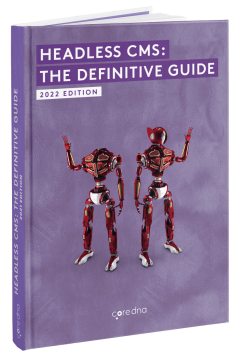
Headless CMS: The Definitive Guide
Core dna Headless CMS guide gives you all the information about the different types of content management systems out there. We highlight the difference between headless and decoupled and give you the framework to choose what solution is best for your business.
What Should You Look For in a Headless Commerce Platform?
Given the rapidly growing demand for customized user experiences, headless eCommerce technology has become an industry-redefining paradigm. Countless headless eCommerce platforms are being introduced in the market every now and then. As a result, choosing one that’s just right for your needs can be challenging.
Here are some of the crucial parameters you need to consider while comparing different headless commerce platforms:
Integration: This is one of the most critical parameters in any headless commerce platform. integration essentially defines how well it works with other digital assets and entities. It is the one aspect that stands out most for both your consumers and developers. A well-integrated platform should enable seamless integration with different APIs.
Effective integration can help steamroll any issues that might come up at both the front and back ends. The better integrated a platform is, the richer the customer experience will be.
The best headless commerce platforms offer easy integration with a variety of tools. Reporting tools are one such category. Integration with Google Analytics, for instance, will tell you how effective your sales and marketing efforts have been by constantly monitoring KPIs such as customer behavior, user journeys, and eCommerce website traffic. It will provide actionable insights in real-time for course corrections, whenever needed.
Payment gateways: One of the last stages in the user journey, payment gateways are right at the top of essential parameters in a headless platform. Payment gateways enable secure and smooth transactions between customers and businesses in an eCommerce setup.
That being said, we are now at a stage where AI-enabled smart payment gateways handle much more than just transactional interactions. Instead, they are built to remind you of recurring payments, highlight conversion rates, and provide support for a variety of payment methods. Last but not least, they also play a major role in fraud detection and prevention.
It boils down to you which payment gateway you wish to go for, considering your business size, average ticket value, and other metrics.
Workflow enhancements: Deploying a headless commerce functionality means you’re looking to have added flexibility, scalability, and efficiency. Workflow enhancements help you achieve all that, and then some.
Enhanced workflows not only drive operations efficiency and effectiveness but also elevate overall customer experiences by streamlining the entire process.
Security: A headless eCommerce platform that is certified and security standards-compliant will help you gain customer trust and generate positive sentiments around the brand. Your headless platform should, ideally, be compliant with the highest security standards and adhere to the latest guidelines. As eCommerce platforms deal with financial transactions and customer data, it's imperative to protect these data points with due diligence.
Cost: Let's talk about cost in terms of value proposition. Price points and pricing models can vary drastically with each headless ecommerce system. Your focus should be on getting the best value proposition - the highest potential benefits at the best possible price.
Customer service: A solution-oriented and quick customer support service is a primary need for any business while deploying a headless e-commerce platform. It ensures peace of mind for customers while building credibility for the brand.

Headless Commerce vs Traditional eCommerce
The architectural framework of a headless commerce platform brings a modular approach to traditional architecture by making the front and back ends independent of each other.
The most significant advantage of this characteristic is the improved scalability and flexibility it provides. With the front and back ends being separated, developers are free to leverage different stacks of technologies and tools for each side. This offers a much higher degree of customization than traditional platform architecture and produces better results.
Traditional eCommerce, on the other hand, involves a more straightforward take on building a commerce platform. It covers both ends of the eCommerce platform under one ceiling. That’s why it is also referred to as an end-to-end methodology.
Here, everything from the front-end interface to back-end operations like overseeing payment gateways, inventory management, and databases is governed by a single platform. That makes both ends dependent on each other.
That means any changes to the back end will require some tweaking with the front end as well. That is not the case with headless commerce platforms.
The Complexity of Headless Platforms
While headless commerce platforms bring unrivaled benefits in terms of flexibility and scalability, they are also relatively cumbersome to manage. At the very least, that brings additional workloads into daily operations.
Everything from managing reviews to publishing content and managing inventory requires inputs at both ends of the platform. The number of systems required to manage different aspects of eCommerce businesses can grow multifold with headless commerce platforms.
You might find headless platforms difficult to get started with if your objective is to simplify business operations. If your priority is long-term preparedness, adaptability, and future-proofing, however, you can easily overcome the initial challenges that come with such platforms.
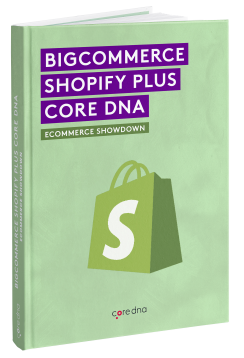
eCommerce Comparison, Shopify vs Core dna
BigCommerce vs Shopify vs Core dna comparison eBook.
Different Headless Commerce Platforms
Let’s now take a look at some prominent headless commerce examples available in the market.
Shopify
Probably the most popular eCommerce platform in the world, Shopify is the king of the hill when it comes to delivering effective and efficient online stores. The platform leaped ahead into the future with its GraphQL API, as it could now be integrated with headless commerce architecture with the introduction of Shopify Plus. This transformation made Shopify a household name in the eCommerce space, where it emerged as one of the top contenders.
Functionality
Shopify Plus provides you with the liberty and advantages of omnichannel publishing. You also get complete control of entire user journeys and spot different trends in
how users interact with your store across various devices and touchpoints.
Pricing
You can avail of a free trial, or go straight for the regular plan at $29 a month. The much revered Shopify Plus SaaS service for enterprises would set you back by around $2000 per month.
Integration
Shopify Plus allows easy integration with almost all platforms and management software crucial to your business. That includes ERP, PIM, CMS, customer relationship management (CRM), and many others.
Application Support
On the app front, the platform offers multiple integration options. For instance, Apple Business Chat, Slack, Google Sheets, and many other popular services.
User Interface
Shopify’s user interface is clean and intuitive, with well-labeled and easy-to-read menus. Even the uninitiated will have little trouble exploring and understanding the nuances of the platform. The ease of use prevails at both the front and back ends. You can refer to the Shopify community forum if you encounter difficulties across any vertical of the platform. You can always reach out to their phone and live chat customer support if that doesn’t help.
Salesforce Commerce Cloud
What was previously known as Demandware in the B2C landscape and CloudCraze in the B2B sector has now become the Salesforce Commerce Cloud.
The two biggest fortes of this platform are its enhanced layer of security and the agility it bestows your CMS with. The platform also features an entire, exclusive app library for easy and enhanced integration of multiple marketplaces and other fundamental elements.
Built by one of the most prominent customer relationship management names in the industry means there’s a lot going in favor of Salesforce Commerce Cloud. Its inherent CMS capabilities are seamless when it comes to integration.
You can easily connect your store and enjoy a simplified unification of all your customer data in one place. This helps in targeting audiences with precision and agility and enables you to provide them with a richly personalized experience.
On the whole, these features promise better sales figures and higher omnichannel revenue. The platform is backed by AI for easy onboarding and introduction to customers.
Pricing
Salesforce reveals pricing only on request.
User Interface
Given the sheer number of options and drop-down menus, the user interface might seem a bit loaded at first. However, it appears clean and intuitive as your progress and has a sense of polished appeal.
Integrations
Salesforce Commerce Cloud offers robust integration options with the entire Salesforce family of products. Beyond that, it offers third-party pre built integrations with essential tools, if required.
Customer Service
There is live chat and phone support to help you out with any issues. Salesforce also offers access to a vast repository of resources in different formats covering almost all possible sections.
Magento (Adobe Commerce)
Magento, now popularly known as Adobe Commerce, is a headless solution offering a high degree of customization. Its USP is that it lets developers build custom applications by leveraging features native to this platform.
Another advantage of Abode Commerce is that it enables the integration of physical and digital commerce as its omnichannel solutions are present on the cloud.
The platform gives you a central database to track and manage your inventory across various locations and at various stages of the supply chain. The inventory management system gets updated in real-time so business owners can have a clear idea of stocks.
Adobe Commerce also offers robust analytical tools. Data is presented in a visually engaging format for quick insights and helps you make better-informed decisions in no time.
Integrations
REST and SOAP web API frameworks are easily integrated into the Adobe Commerce framework. The full range of integrations covers many options such as CMS, PIM, ERP inventory management, and more.
Pricing
Adobe Commerce pricing details can only be accessed upon request.
User Interface
The Adobe Commerce user interface is clean, polished, and intuitive. It features a sidebar menu on a central dashboard that makes it easy to explore and use the platform’s many features.
Application Support
The platform’s Help Centre offers extensive support options. Customers have the option to generate a ticket for just about any query. This ensures a delightful customer experience overall.
Adobe Commerce also has a central repository of resources for best practices, monitoring tools, and other essential references for deep insights about your eCommerce website.
Commercetools
Commercetools has emerged as a popular option among businesses that aim to provide omnichannel experiences at a larger scale. Its headless approach is API-driven for the added benefit of customization and flexibility.
The use of APIs eliminates the need for SQL. The platform also offers robust inventory management capabilities to take care of all supply chain needs of your online store.
Pricing
Commercetools’s pricing is available only on request.
User Interface
The intuitive user interface follows a simple theme with a clean, uncluttered outlook. Everything from managing product data and order details to information on retail channels is effortlessly handled. Other features like batch processing and configurable forms make everyday tasks super easy.
Integrations
The platform offers a variety of integrations, such as for Contentstack, Cybersource, Frontstatic, and front-end CMS systems.
Customer Service
The platform doesn’t offer phone or live chat support. Customer service is limited to email and might, therefore, be cumbersome at times.
Customizations
You can deploy APIs to carry out a variety of customizations on Commercetools. Giving a personal touch to pre-existing categories with the help of these APIs is easy and helps reduce dependency on templates.
Core dna
We are a team of user-friendly platform fanatics. We built a content and commerce platform designed to be used by marketers while still offering a dream development environment. We power some of the most complex websites seamlessly. - Read about how YMCA increased their registration by 500% with Core dna.
Core Commerce is what you would call an optimized sales machine . It elevate your sales game with an integrative commerce approach and create high-performing sales funnels. The API-first strategy makes Core commerce adapt to your needs and existing tech stack, ensuring a secure, unified, and successful business.
Pricing
Core dna pricing is available here.
User Interface
Core dna is a platform built for marketers and developers alike. Say bye to the time you needed IT for every single change in your website. With global components structure, marketers can create new pages and duplicate content with ease. Core dna is built to give freedom to marketers while being still robust to handle the most complex architectures.
Customer Service
At Core dna we are not just a product, we are also your agency. Your support team is your partner in crime. They are always an email or phone call away.
Customizations
With its API first approach, Core dna makes it simple for your business to connect and automate tasks between and within web applications. A library of custom automations and workflows to save you time and boost efficiency without any technical know-how.
Traditional eCommerce Platforms
As we’ve discussed above, the programming logic of an eCommerce site’s front and back ends are linked in legacy commerce platforms. Any changes made to one side impact the other, sometimes in unexpected ways.
For instance, you might tweak a design element on the digital storefront and unintentionally break a back-end function such as payment processing.
To limit issues of this type, traditional eCommerce platforms create predetermined front-end solutions that work in harmony with the back end system. This helps with ensuring your eCommerce website runs smoothly, but it does hamper customization.
Traditional commerce platforms also let you make minor modifications, such as changes to font size or background colors, without any coding skills.

How to Choose the right eCommerce Platform
Definitive guide to choosing an eCommerce platform.
Key Differences Between Headless eCommerce and Traditional eCommerce Options
Here’s how headless and traditional commerce platforms differ from each other:
Architecture: Traditional or legacy ecommerce platforms are based on a monolithic architecture with firmly integrated backend and front end. A headless solution, on the other hand, uses a decoupled commerce system consisting of an independent back end and front end.
User experience: Headless architecture can feature a single-page application or SPA. It is used for faster page loading times and a more seamless user experience. On the contrary, a traditional architecture requires the entire system to be loaded, resulting in a not-so-seamless user experience, comparatively speaking.
Customizations: Given their siloed framework, traditional platforms offer far fewer customization and integration options compared to headless commerce platforms.
Headless Commerce: Key benefits
With average attention spans diminishing rapidly, the competition for better brand recall and retention has gotten even more fierce among brands and businesses. Headless commerce architecture is one of the trends that aim to address this issue. How does it benefit eCommerce platforms? Scroll down for a list of benefits of a headless commerce system.
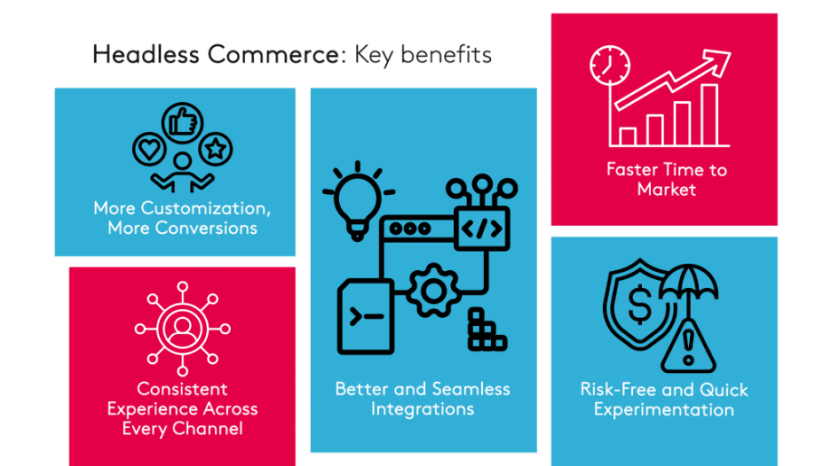
More Customization, More Conversions
Headless platforms are a far cry from the monolithic architecture of traditional commerce platforms. This enables you to create diverse user experiences based on your business needs. As headless commerce features a decoupled front and back end system, trying out new customizations is less resource-intensive and less risky since the entire site infrastructure does not have to be disturbed.
This enables free-flowing customizations for continuously better customer experiences. Customer data is stored in a centralized receptacle, allowing all teams to be on the same page and take insights from the same database. This practice enables businesses to target prospects better and create memorable personalized experiences to drive conversions.
Consistent Experience Across Every Channel
When you operate a business across multiple channels, you are bound to give the same customer experience at all touchpoints. Headless commerce helps you achieve this by delivering a consistent omnichannel experience.
Monolithic platforms make similar claims about providing omnichannel experiences, but your entire effort might go in vain if they are not available on just one particular platform. That makes it wiser to stick to a headless commerce system as long as consistent omnichannel experiences are a priority.
With headless commerce, you can create multiple front-end variations for a variety of needs. The centralized approach of a headless commerce platform makes it a breeze to deliver the same experience across. Customer data too is stored in one centralized location for coupling with APIs.
Headless commerce platforms are expected to go much beyond where they are today with the advent of technologies such as the Internet of Things (IoT) and augmented reality.
Better and Seamless Integrations
Headless commerce is API-driven. They simplify communication within the software architecture and make administration more effective and efficient. The seamless flow of information also results in reduced latency between any two touchpoints.
Better integrations also translate to better customer experience (CX), which is easily delivered via an API. Integrations are rapid and seamless because of the front and back ends being decoupled.
Faster Time to Market
Faster adaptability is a key differentiator in digitalized markets. Headless commerce will help keep your business ahead of the curve, enabling business owners to launch multiple sites across different brand verticals.
Courtesy of its inherent agility, headless commerce can reduce your go-to-market time considerably. That makes you better placed at keeping up with customer expectations, and in the long run, being a step ahead of them. Headless commerce platforms are a necessity for those who are passionate about innovating without disturbing the backend operations of a software framework.
Headless commerce platforms can support new technologies as they emerge and cut down the time to market drastically. It means that marketing teams will be able to launch multiple sites across various brands, divisions, and portfolios, and they’ll be able to do it quickly.
And owing to the flexibility offered by headless software, brands can go to market faster even if customer preferences change overnight. Whether you want to try out new variations in shopping experiences or surpass rapidly evolving customer expectations, a headless platform is a way to go should you want to experiment/innovate without compromising backend functions.
Risk-Free and Quick Experimentation
Experimentation leads to innovation and evolution in the ever-changing landscape of eCommerce. A brand-new innovation is more likely to offer better customer experiences than a recent one. Experimentation eventually leads to better products and services and, by extension, better customer experiences.
Since headless commerce reduces the risk involved in experimentation because of its decoupled architecture, it frees up room for more extensive and enhanced levels of experimentation. This radically improves the capacity for experimentation with aesthetics, page layouts, texts, offers, and more with minimal risk.
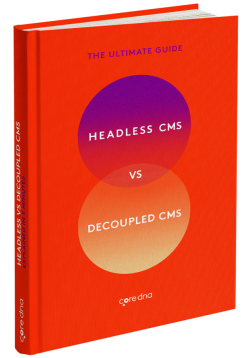
Headless vs Decoupled CMS Architecture
Do you know the difference between a headless and decoupled CMS? Learn everything you need to know before making your next content management system decision.
How Does Headless Commerce Support Omnichannel Retail
Headless commerce brings added scalability, efficiency, flexibility, and agility to the eCommerce architecture. The presentation layer and administrative layer communicate seamlessly and without disruptions through APIs in this two-tiered arrangement.
Nothing beats headless architecture when it comes to offering the optimum customer experience across all channels of a business. It is undoubtedly one of the biggest advantages that headless commerce has bestowed on omnichannel retail. The customer experience takes center stage while other crucial parameters align accordingly.
Given the omnichannel nature of a retail business, the involvement of multiple teams for various business aspects is quite evident. With headless frameworks featuring a central repository of customer data collected from multiple touchpoints, all teams can operate on the same data set and be on the same page at all times.
This practice not only improves overall efficiency but also reduces the possible chance of any errors due to discrepancies in data sets.
Is Headless Commerce Fit For All eCommerce Stores?
Headless commerce is your solution if you seek long-term preparedness for your business and want to transform it into a more agile and future-ready entity. It doesn’t matter what size or kind of eCommerce store you run.
That being said, if you are someone who likes to do things the old-school way and wants one central dashboard to control both the front end and the back end of your business, you may want to stick to legacy commerce platforms. Since headless platforms introduce multiple systems, it’s quite natural to feel overwhelmed at the beginning of a transition to a headless platform.
In the long run, however, headless commerce is a better value proposition given its sheer bulk of merits, which make it a perfect fit for all eCommerce stores.
Digital Experience Platform (DXP)
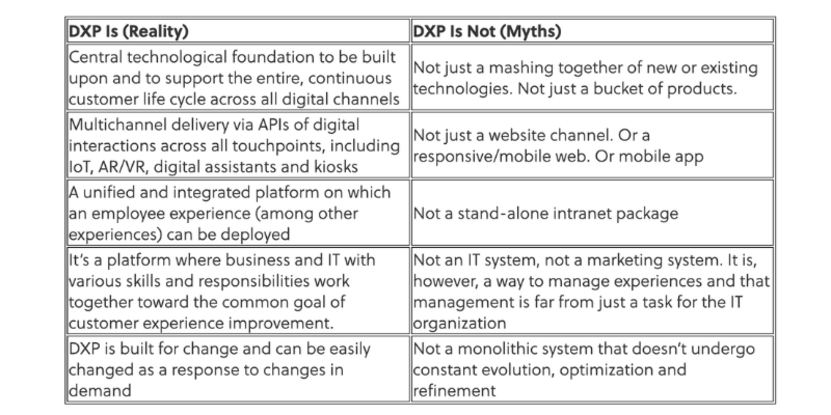
A Digital Experience Platform ditches the siloed architecture of the past. Instead, it creates a central hub of resources and data for all teams to access. This enables enhanced effectiveness and efficiency of omnichannel experiences, be it creation, management, or delivery and optimization.
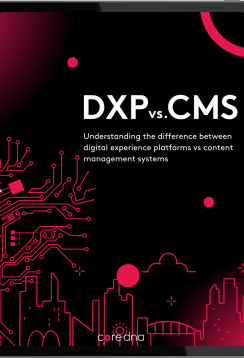
Digital Experience Platform (DXP) vs CMS
Digital Experience Platform helps you increase your customers' satisfaction. Offering an omnichannel experience is mandatory to ensure your customers can interact with your brand wherever they are.
Ready to Go Headless?
It’s time to make the decision. The technology landscape is shape-shifting even as you read this. As customer priorities and preferences change at a moment's notice, businesses must be able to predict trends rather than just follow them. A lot of it can be achieved through a headless commerce platform.
For eCommerce brands to sustain and succeed, adaptability and agility are key. Headless platforms are ideal drivers of these two virtues in highly competitive scenarios.
Need Expert Help to Select the Right eCommerce Solutions Software?
Get in touch with Coredna for help picking the best eCommerce solutions for your business.
Our team of industry experts takes the time to understand your present business needs and future aspirations. You’ll have no trouble finding the right eCommerce solutions that simplify your digital presence while outperforming your competitors.
FAQs
Is headless CMS good for eCommerce?
A headless content management system (CMS) refers to a backend-only software framework that is devoid of a front end. A headless CMS leverages APIs for various aspects of content management, be it handling, updating, or storing content in one place. Any front-end integrations can be done easily on a headless CMS since it is a decoupled entity.
The headless approach is widely regarded as one of the most profound ways of future-proofing and making eCommerce businesses more scalable, flexible, and agile when it comes to business transformation. The headless content management system approach is, therefore, very advantageous in the eCommerce sector.
What is headless eCommerce vs. traditional eCommerce?
Let’s take a look at some of the key differences between headless eCommerce and traditional eCommerce:
Fewer Front-End Limitations
Headless eCommerce reduces front-end limitations for back-end developers. In a traditional setup, the slightest change at the back end requires huge risk and effort as the entire code, database, and front end must be altered accordingly.
With a headless ecommerce platform, developers enjoy the freedom of making changes whenever required without the possibility of front-end repercussions.
Customization and Personalization
Both the user-facing end and the back end (administrative end) need to adhere to a prefabricated template-styled experience in a traditional ecommerce setup.
In a headless ecommerce platform, on the contrary, the independent nature of the front and back ends leaves room for infinite customization and personalization options to be included as per business requirements.
Better Time-to-Value Ratio,
In a traditional ecommerce platform, a small change requires multiple iterations of code changing at both ends along with other efforts. A headless ecommerce platform is a more experience-centric approach with fewer resources and time required for alterations. In short, it offers a much better time-to-value proposition.
A traditional ecommerce architecture often presents limitations when compared to its headless counterpart. The siloed and monolithic framework of a traditional ecommerce platform is connected to the back end at all times. This limits flexibility and possibilities of customization. That is why a traditional framework is not desirable when you are looking to offer omnichannel experiences.
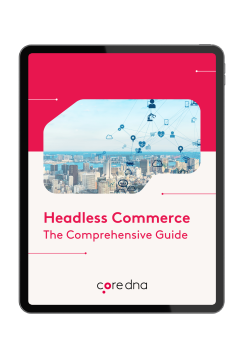
Headless Commerce: The Ultimate Guide
To stay competitive in today market, an omnichannel experience is mandatory and can only be achieved with a headless platform. With Core dna decoupled solution, you get the best of both worlds: A headless commerce with content preview and templates for a faster time to market.













